Adopting new technology in agriculture is a significant investment that can be highly profitable if done well, or costly if not. The first step is to be aware of and understand the issues that can influence the outcome, followed by gathering the necessary information to make informed decisions. A self-assessment tool was created to help evaluate your readiness and awareness on issues impacting successful automation adoption.
Background
The UW-Madison Division of Extension Farm Management and Dairy Programs worked together on a project which investigated the experiences of producers using Automatic Milking Systems (AMS) to understand its impacts. Installing AMS is a significant investment that requires a major shift in management. It can improve productivity, efficiency, consistency, cow comfort, and overall welfare, but it also presents challenges that farmers must carefully evaluate.
The goal of the project was to create educational tools to help farmers make informed, strategic, and economically sound decisions about adopting this technology.
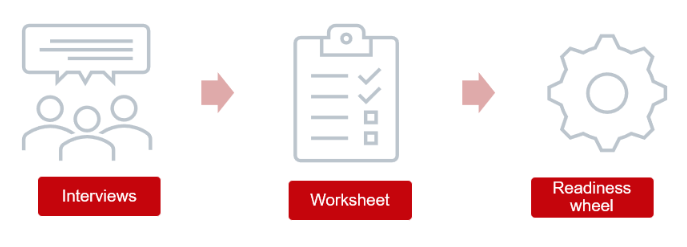
To meet the project goals, we followed a few key steps:
- We started by reviewing existing research to guide the creation of a case study questionnaire.
- Next, we conducted interviews to gather insights from dairy farms using AMS. This helped us understand their successes, challenges, and lessons learned.
- Then, based on this information, we created a worksheet with important questions to help farmers evaluate their readiness for adopting new technology. The goal was to encourage folks to think critically about key factors.
- Finally, we developed a visual tool called the “Technology Readiness Wheel.” This tool helps farmers self-assess, identify their strengths, and pinpoint areas that need improvement before implementing AMS.
From the interviews, which included three farms, we found that adopting AMS brought several benefits. Farmers reported greater flexibility in managing tasks and schedules, improved milk production, enhanced cow comfort, and reduced labor needs. But, of course, these benefits came with challenges. For example, high upfront costs and ongoing maintenance expenses that were often underestimated. Additionally, the transition to automation required more advanced technical skills and employee training, which added complexity.
You can download and use the Ag Tech Worksheets for use on your own farm either individually or with your farm leadership team.
The key considerations addressed in the Ag Tech Worksheets are important questions to ask yourself divided into nine key areas.
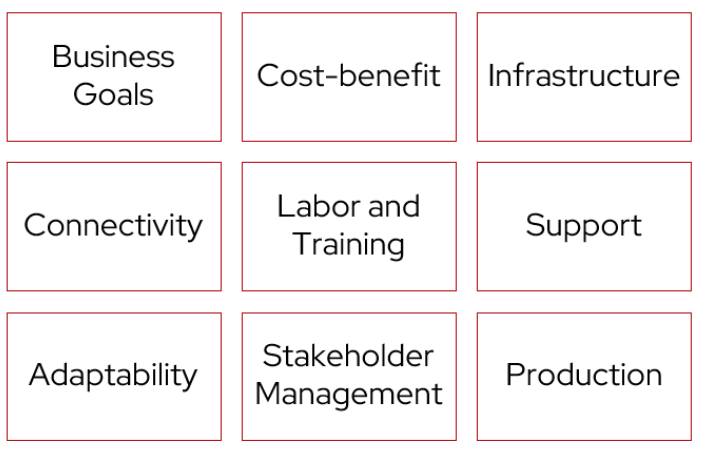
Key Questions to Consider
- Business Goals
- What are your business and family goals?
- How does this technology fit into your long-term strategy?
- What is the primary purpose for making this change?
- What tasks or bottlenecks could this technology improve?
- How could future technology impact your investment?
- What is the technology’s lifespan?
- What is the plan for updates and obsolescence?
- Cost-Benefit Analysis
- How will the technology affect production?
- How much does it cost to buy and set up the equipment and infrastructure?
- How will the change impact operating costs (feed, labor, repair & maintenance, veterinary, utilities, insurance, etc.)?
- What is the useful life before replacement?
- How much does it cost to keep the equipment running and maintained?
- How quickly do you expect to see a return on investment (ROI)?
- What strategies can you use to manage surprise costs?
- How does ROI change with productivity improvements, cost reductions, and better resource management?
- Infrastructure Compatibility
- Is the technology compatible with your current infrastructure and systems, or will you need to make changes to your setup?
- How will input needs (chemicals, feed, seed, sand, etc.) change?
- What impact will there be on infrastructure like ventilation, plumbing, electrical, water, and manure systems?
- How much energy does the technology use and how will your energy needs change (gas, electricity, propane, etc.)?
- What backups should be in place in case of hardware failures or data breaches?
- Connectivity Requirements
- Do internet connections meet the technology’s network requirements?
- How does the tech perform with unstable connectivity?
- How do you feel about being constantly connected to the technology through notifications and alarms?
- How does it handle and secure sensitive farm data?
- What measures are in place to prevent unauthorized access?
- Does the technology work well with your existing farm management systems and software?
- Will you need new software or subscriptions?
- Do you have a plan for managing and using the data or will you need to hire someone to help?
- Labor and Training Needs
- How easy for people to learn the new system, no matter their technical skills?
- How much training will your staff need to use and maintain the equipment?
- What additional safety training is required?
- How will the changes affect your total payroll costs?
- How much time and labor will the technology save?
- Are there user groups you can join?
- Do you or your staff like and have the capacity to solve problems?
- Support and Maintenance
- How well-known and trusted is the supplier or manufacturer?
- What extra agreements or subscriptions are required?
- Have you checked reviews or sought testimonials from other users?
- What maintenance and support services does the manufacturer offer?
- How often will maintenance be needed?
- How long will maintenance take, and how will it affect daily operations?
- What is the likelihood of reliable and timely support for technical issues?
- Adaptability
- What are the short-term effects of switching to the new technology, and how long will they last?
- Can the technology grow with your farm’s operations?
- How will the technology adapt if your business size or structure changes?
- How well can the technology adjust to changes in crop patterns or livestock management?
- How does the technology perform in different weather conditions, and can it handle extreme weather?
- How does the equipment adapt to unexpected changes in the farming environment?
- What are the backup plans if bad weather or other factors affects the technology’s performance?
- Stakeholder Management
- What is the strategy for communicating changes to and integrating feedback from employees and stakeholders?
- What is the environmental impact of the new technology and does it match your sustainability goals?
- What are other farmers, consultants, agricultural associations, and University research programs saying about the new technology?
- Does the process for implementing the new technology comply with all state and federal laws and regulations?
- How will the new technology impact any licenses or certifications?
- If there is a written contract, are both your and the supplier/service provider’s obligations clear? How will the ‘fine print’ impact your use of the new technology and the supplier’s use of your farm data?
- How will the new technology impact your insurance coverage? Will it impact your coverage types, levels, and premiums?
- Production Changes
- What changes in management practices, protocols, processes, and procedures will be necessary with the implementation of the AMS related to the following areas?
- Feeding and nutrition (feed cost, nutritionist skills)
- Milk production and components (butterfat, protein)
- Milk quality and SCC levels (testing SCC)
- Data management (alerts, decision-making)
- Milk disposal (non-saleable milk for calves)
- Reproduction (activity, breeding protocols)
- Hoof health (footbaths)
- Bedding management (bedding type, protocols)
- Herd health (identification, monitoring sick cows, administration of medications)
- Pen management and grouping strategies
- Animal wellbeing, behavior, and welfare
- What changes in management practices, protocols, processes, and procedures will be necessary with the implementation of the AMS related to the following areas?
By thoroughly assessing these areas, you can make more informed decisions and increase the likelihood of successful technology adoption in your agricultural operations.
This worksheet helps farmers understand the impact of new robotic and automated technologies in dairy farming. It explores real-world experiences and results, providing an educational tool to guide farmers in making smart, strategic, and cost-effective decisions that consider all aspects of their farming operations and lifestyle.
Tool created by Kevin Bernhardt, Farm Management Specialist with the UW-Madison Division of Extension.
Survey questionnaire created by the UW-Madison Division of Extension team (Stephanie Plaster, John Shutske, Angie Ulness, Jackie McCarville, Carolina Pinzon, Leonard Polzin, Kelly Wilfert, Nesli Akdeniz Onuki, and Kevin Bernhardt).

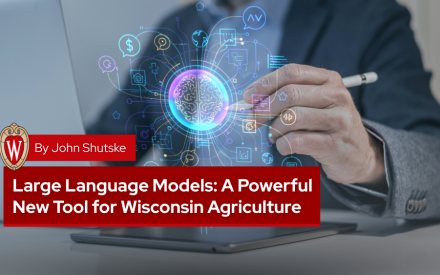 Large Language Models: A Powerful New Tool for Wisconsin Agriculture
Large Language Models: A Powerful New Tool for Wisconsin Agriculture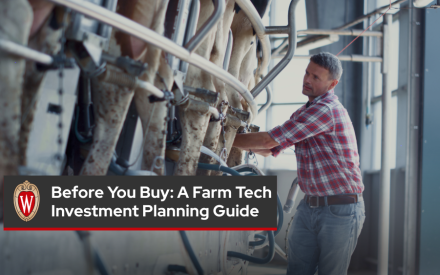 Before You Buy: A Farm Tech Investment Planning Guide
Before You Buy: A Farm Tech Investment Planning Guide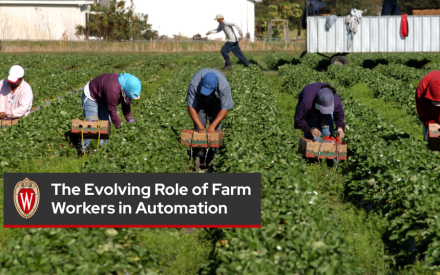 Balancing Technology and People: The Evolving Role of Farm Workers in Automation
Balancing Technology and People: The Evolving Role of Farm Workers in Automation 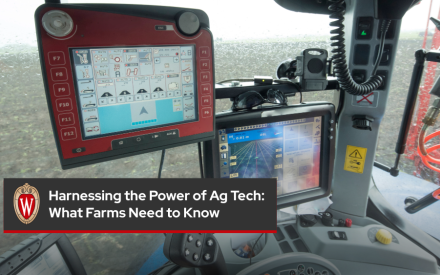 Harnessing the Power of Ag Tech: What Farms Need to Know
Harnessing the Power of Ag Tech: What Farms Need to Know


